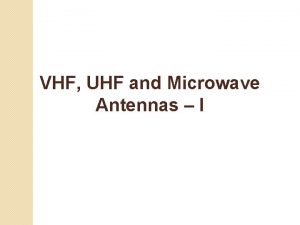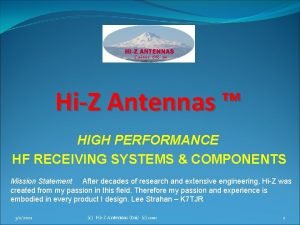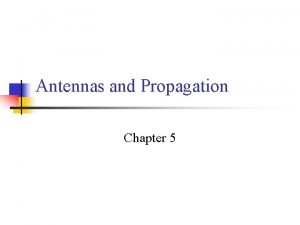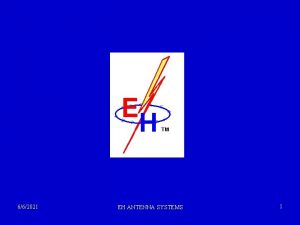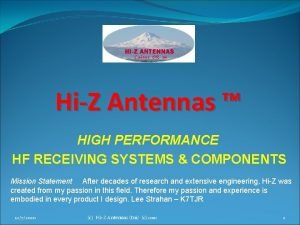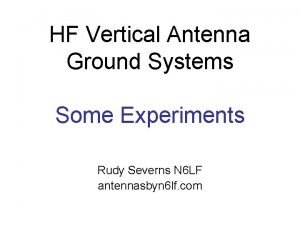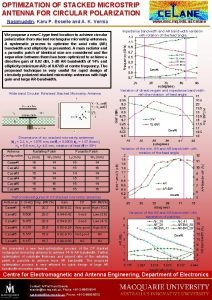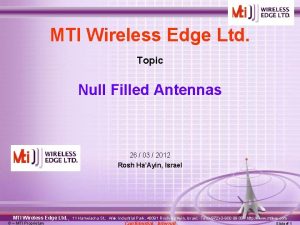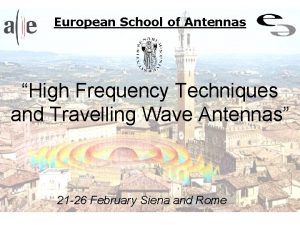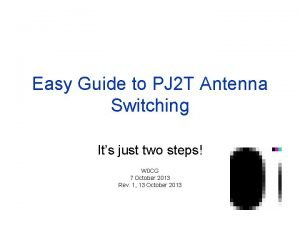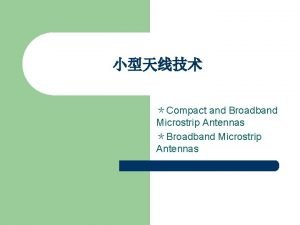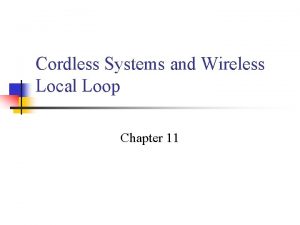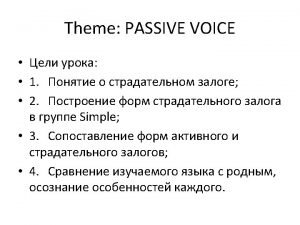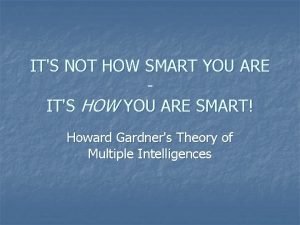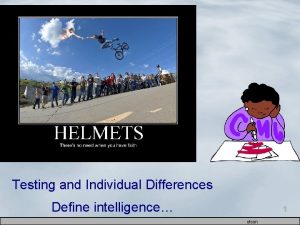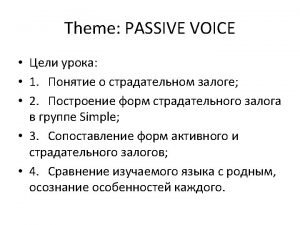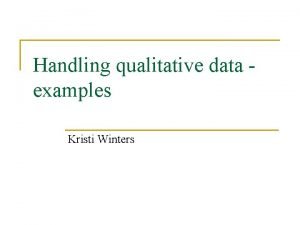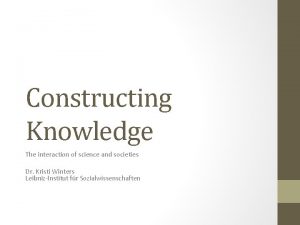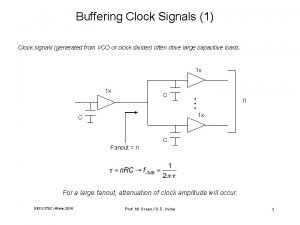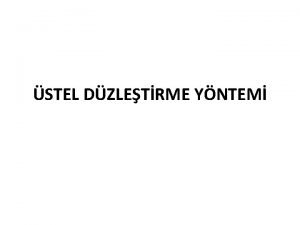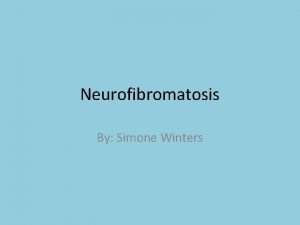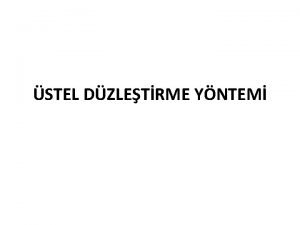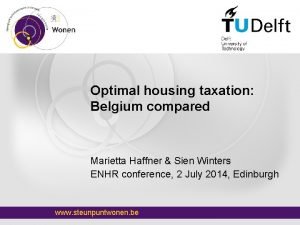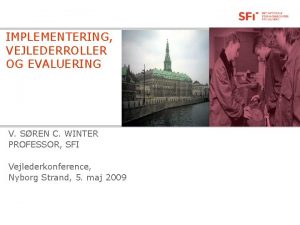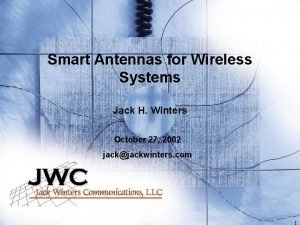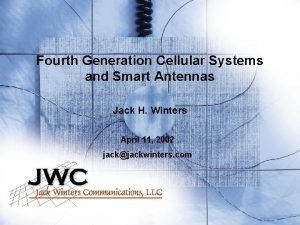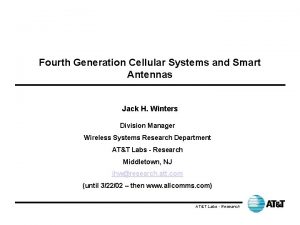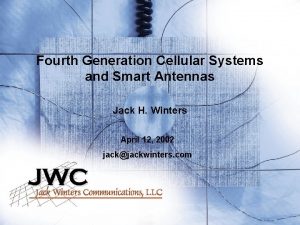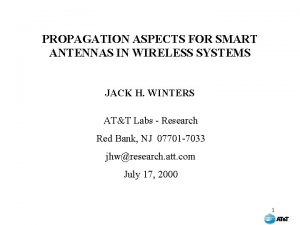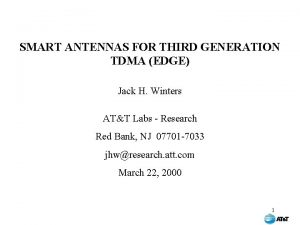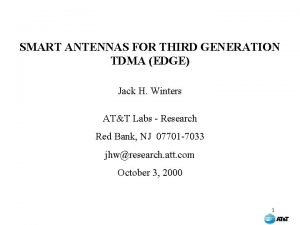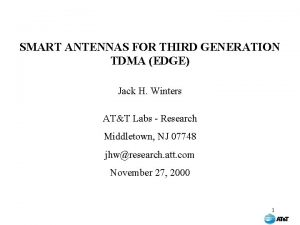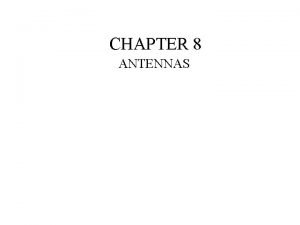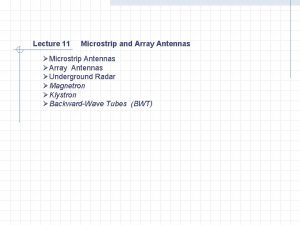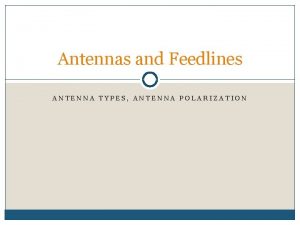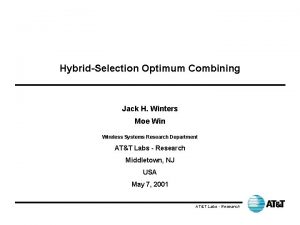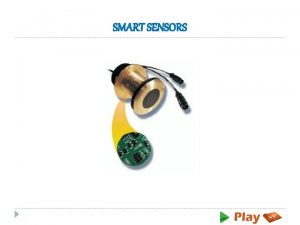Smart Antennas for Wireless Systems Jack H Winters























![EQUALIZATION • Delay spread: Delay spread over [(M-1) / 2]T or M-1 delayed signals EQUALIZATION • Delay spread: Delay spread over [(M-1) / 2]T or M-1 delayed signals](https://slidetodoc.com/presentation_image_h/dda77debb96eb334424c65114477feaf/image-24.jpg)















































![SMART ANTENNA RESEARCH TDMA Evolution [Research Issues] • IS-136: • Optimum combining uplink / SMART ANTENNA RESEARCH TDMA Evolution [Research Issues] • IS-136: • Optimum combining uplink /](https://slidetodoc.com/presentation_image_h/dda77debb96eb334424c65114477feaf/image-72.jpg)




























- Slides: 100

Smart Antennas for Wireless Systems Jack H. Winters AT&T Labs - Research Red Bank, NJ 07701 -7033 USA jhw@research. att. com July 16, 2000

TABLE OF CONTENTS I. Wireless Impairments ………………. 4 II. Antenna Diversity …………………. 8 III. Smart Antennas …………………. . . 30 IV. Applications ……………………. 33 A. Range Increase ……………. . 48 B. Capacity Increase ……………. . . 57 C. Data Rate Increase ……………. 65 V. Issues ………………………. 73 A. Equalization ………………. . . 74 B. Correlation ………………. 78 C. Transmit Diversity ……………. 79 D. Multipath Distribution …………………. . . 84 E. Downlink ………………… 85 F. Experimental PCS Results ………………. 88 VI. Conclusions ……………………. 100

GOAL In this tutorial, we will discuss current and future antenna technology for wireless systems and the improvement that smart and adaptive antenna arrays can provide. We will describe standard cellular antennas, smart antennas using fixed beams, and adaptive antennas for base stations, as well as antenna technologies for handsets. We will show the potential improvement that these antennas can provide, including range extension, multipath diversity, interference suppression, and capacity increase. The issues involved in incorporating these antennas into wireless systems, including 2 nd generation (CDMA, GSM, and IS-136) and 3 rd generation (WCDMA and EDGE) cellular systems, in different environments, such as rural, suburban, and urban areas, as well as indoors, will be described in detail. Theoretical, computer simulation, experimental, and field trial results will be presented. This tutorial should provide a basic understanding of the antenna technology options and their potential in wireless systems.

WIRELESS SYSTEM IMPAIRMENTS Wireless communication systems are limited in performance and capacity by: Delay Spread Limited Spectrum Rayleigh Fading Co. Channel Interference

MULTIPATH • Many paths Rayleigh fading (complex Gaussian channel) • Flat fading (negligible ISI) if 10% (symbol period) • Fading is independent with distance ( /4), direction, and polarization Amplitude • Distribution of bit error rate (BER) outage probability P 0 = Pr(BER 0) Time

DELAY SPREAD 10% Time domain Delay spectrum Double Spike Exponential Power Frequency domain Delay |H(f)| f Intersymbol interference (ISI)

CO-CHANNEL INTERFERENCE (CCI) • Cellular systems use frequency reuse for capacity increase F 1 F 2 F 3 N=3 • To increase capacity further: shrink cell size, increase reuse • N = 7 frequency reuse currently • Six closest interferers (S/I set by N only) • One interferer usually dominates • CCI assumed Gaussian noise in most studies

ANTENNA DIVERSITY Multiple antenna elements with received signals weighted and combined ANTENNA 1 USER ANTENNA 2 ANTENNA M With multipath, diversity gain requires independent fading: • /4 spacing • Direction • Polarization OUTPUT SIGNAL

ANTENNA AND DIVERSITY GAIN Antenna Gain: Increased average output signal-to-noise ratio - Gain of M with M antennas - Narrower beam with /2 -spaced antenna elements Diversity Gain: Decreased required receive signal-to-noise ratio for a given BER averaged over fading - Depends on BER - Gain for M=2 vs. 1: • 5. 2 d. B at 10 -2 BER • 14. 7 d. B at 10 -4 BER - Decreasing gain increase with increasing M - 10 -2 BER: • 5. 2 d. B for M=2 • 7. 6 d. B for M=4 • 9. 5 d. B for M= - Depends on fading correlation • Antenna diversity gain may be smaller with RAKE receiver in CDMA

DIVERSITY TYPES Spatial: Horizontal separation - Correlation depends on angular spread Polarization: Dual polarization - Low correlation - Horizontal receive 6 -10 d. B lower than vertical with vertical transmit and LOS Angle: Adjacent narrow beams - Low correlation typical - 10 d. B lower signal in weaker beam, with small angular spread

BASE STATION ANTENNA OPTIONS 1. 5 ft - 10 ft Conventional Sector Antennas Fixed Multibeam Antenna • 15 d. Bi gain, 120° bw, vertical polarization • 21 d. Bi gain, 4 -30° beams, vertical polarization • 16 d. Bi gain, 90° bw, dual polarization • 2 overlapped beams for spatial diversity • Non-overlapped beams • Multiple overlapped beams for spatial and polarization diversity Adaptive Antenna Array

ADAPTIVE ARRAYS FOR TDMA BASE STATIONS AT&T Wireless Services and Research - Field Trial with Lucent 7/96 -10/96 24 (12 ft) 3 (1. 5 ft) Field trial results for 4 receive antennas on the uplink: • Range extension: 40% reduction in the number of base stations can be obtained 4 to 5 d. B greater margin 30% greater range • Interference suppression: potential to more than double capacity Operation with S/I close to 0 d. B at high speeds greater capacity and quality

COMBINING TECHNIQUES Selection: Output • Select antenna with the highest received signal power • P 0 M = P 0 M

COMBINING TECHNIQUES (CONT. ) Maximal ratio combining: W 1 Output WM • Weight and combine signals to maximize signal-to-noise ratio (Weights are complex conjugate of the channel transfer characteristic) • Optimum technique with noise only • BERM (M-fold diversity gain)

OPTIMUM COMBINING (ADAPTIVE ANTENNAS) • Weight and combine signals to maximize signal-tointerference-plus-noise ratio (SINR) - Usually minimize mean squared error (MMSE) • Utilizes correlation of interference at the antennas to reduce interference power • Same as maximal ratio combining when interference is not present

INTERFERENCE NULLING Line-Of-Sight Systems User 1 • • • User 2 Utilizes spatial dimension of radio environment to: • Maximize signal-to-interference-plus-noise ratio • Increase gain towards desired signal • Null interference: M-1 interferers with M antennas User 1 Signal

INTERFERENCE NULLING Multipath Systems User 1 • • • User 1 Signal User 2 Antenna pattern is meaningless, but performance is based on the number of signals, not number of paths (without delay spread). => A receiver using adaptive array combining with M antennas and N-1 interferers can have the same performance as a receiver with M-N+1 antennas and no interference, i. e. , can null N-1 interferers with M-N+1 diversity improvement (N-fold capacity increase).

SPATIAL VS. ANGULAR DOMAIN • Number of rays number of antennas angular domain (LOS) • Number of rays number of antennas spatial domain (multipath)

THEORY Model: • N transmitters, 1 to N outputs • At each output, 1 desired signal and N-1 interferers • M receiving antennas, with channel matrix C=[Cij], where Cij is the channel coefficient between transmitter i and antenna j 1 1 • INPUTS • • N CHANNEL MATRIX + C • • • Nx. M + M 1 1 RECEIVER PROCESSING M • OUTPUTS • • N

THEORY (CONT’D) Assumptions: • Flat Rayleigh fading • Antennas spaced far enough for independent fading - Ci = [Ci 1 Ci. M] are linearly independent - Cij are complex i. i. d. zero-mean Gaussian random variables • Noise is additive, zero-mean i. i. d. Gaussian Goal: Linear receiver cancels N-1 interferers and maximizes desired signal SNR

THEORY (CONT’D) Solution for N = 1 (no interferers): • • • Maximal ratio combining

THEORY (CONT’D) Solution for N 2 (N-1 interferers): • To cancel interferers W must be orthogonal to C 2 CN • W is the projection of C 2 CN onto the M-N+1 dimensional space orthogonal to • Since the elements of are i. i. d. Gaussian random variables, W has M -N +1 dimensions, with the same statistics as C 1, independent of C 2 CN • C 2 C 1 W

RESULT A receiver using linear (optimum) combining with M antennas and N-1 interferers has the same performance as a receiver with M-N+1 antennas and no interference • Null N-1 interferers with M-N+1 diversity improvement (N-fold capacity increase)
![EQUALIZATION Delay spread Delay spread over M1 2T or M1 delayed signals EQUALIZATION • Delay spread: Delay spread over [(M-1) / 2]T or M-1 delayed signals](https://slidetodoc.com/presentation_image_h/dda77debb96eb334424c65114477feaf/image-24.jpg)
EQUALIZATION • Delay spread: Delay spread over [(M-1) / 2]T or M-1 delayed signals (over any delay) can be eliminated • Typically use temporal processing with spatial processing for equalization: LE MLSE/DFE

MIMO CAPACITY INCREASE • With M antennas at both the base station and mobiles, M independent channels can be provided in the same bandwidth if the multipath environment is rich enough. • 1. 2 Mbps in a 30 k. Hz bandwidth using 8 transmit and 12 receive antennas demonstrated by Lucent (indoors). • Separation of signals from two closely-spaced antennas 5 miles from the base station demonstrated by AT&T/Lucent.

OPTIMUM COMBINING THEORETICAL (ZERO-FORCING) RESULT • A receiver using linear (optimum) combining with M antennas and N 1 interferers has the same performance as a receiver with M-N+1 antennas and no interference • Multipath: M-fold diversity gain • CCI only: N interferers eliminated (M-fold capacity increase • Delay spread: Delay spread over [(M-1) / 2]T or M-1 delayed signals (over any delay) eliminated • CCI and multipath: N interferers eliminated with M-N-fold diversity gain • CCI, delay spread, and multipath: N interferers with delay spread over D symbols with M+1 -(N+1)(2 D+1)-fold diversity gain

OPTIMUM COMBINING - MMSE RESULT Practical systems (typically): • # interferers M • D (M-1)/2 But: • Only need to suppress interference (and ISI) into the noise (not eliminate) • Usually only 1 or 2 dominant interferers and delayed paths Result: • Substantial increase in performance and capacity even with a few (even 2) antennas Note: • Optimum combining yields interference suppression under all conditions (e. g. , line-of-sight, Rician fading)

EXAMPLE - MULTIPATH AND CCI WITH 2 ANTENNAS Theory (zero-forcing): • Dual diversity against multipath (maximal ratio combining) or • Elimination of one interferer (gain = INR - 12. 8 d. B) without diversity gain {INR - interference to noise ratio, BER = 10 -3} MMSE result: • Gain over maximal ratio combining INR/2 (in d. B) with one interferer • Gain of 1 to 2 d. B with 2 to 6 equal-strength interferers

EXAMPLE - MULTIPATH AND CCI WITH ADAPTIVE ANTENNAS Gain over maximal ratio combining (d. B) 12 BER = 10 -3 10 Coherent detection of BPSK 1 Two antennas 5 0 2 3 4 5 6 0 5 10 15 Interference-to-Noise Ratio (d. B) 20 Interferer

SMART ANTENNAS Today: Cellular systems with sectorization (120°) handoffs between sectors f 3 f 1 f 4 f 5 f 6 f 2 For higher performance Narrower sectors Too many handoffs Smart Antenna definition: Multibeam antenna or adaptive array without handoffs between beams

Smart Antennas Switched Multibeam Antenna Adaptive Antenna Array SIGNAL BEAMFORMER SIGNAL BEAM SELECT SIGNAL OUTPUT INTERFERENCE BEAMFORMER WEIGHTS Smart Antennas can significantly improve the performance of wireless systems • Higher antenna gain / diversity gain Range extension and multipath mitigation • Interference suppression Quality and capacity improvement • Suppression of delayed signals Equalization of ISI for higher data rates • Multiple signals in the same bandwidth Higher data rates Switched Multibeam versus Adaptive Array Antenna: Simple beam tracking, but limited interference suppression and diversity gain

SMART/ADAPTIVE ANTENNA ARRAY TECHNOLOGY Commercial Military • high resolution direction-finding • jammer cancellation • interference reduction • signal classification • directional transmission • custom VLSI implementations • mobile, indoor, wireless local loop • range extension • interference reduction with fast fading • signal acquisition and tracking • delay spread equalization • propagation characterization • adaptive retransmission • antenna design and implementations Research Applications 1980 • long range surveillance radars • military communication systems • sonar • geophysical exploration • imaging 1990 2000 • Nortel Smart. BTS - GSM • Meta. Wave Spot. Light • Array. Comm Intelli. Cell • Celwave Smart System - AMPS • Hazeltine IAS - AMPS • Ericsson and Lucent - IS-136

SYSTEM APPLICATIONS IS-136 GSM EDGE CDMA • Range increase (2 GHz versus 900 MHz 9 d. B) • Capacity increase (higher reuse) • Data rate increase (wireless Internet access)

IS-136 • TDMA with 3 users per channel • /4 DQPSK at 48. 6 kbps • 162 symbols/slot • 14 symbol synchronization sequence • Two receive antennas at base IS-136 Timing Structure Digital Traffic Channel TDMA FRAME 40 ms 1 2 3 4 5 6 TIME SLOT 6. 687 ms (162 symbols) 3 3 8 14 61 6 6 61 G R DATA SYNC DATA SACCH CDVCC DATA MOBILE TO BASE 14 SYNC 6 65 1 5. 5 SACCH DATA CDVCC DATA RSVD CDL BASE TO MOBILE Symbol duration 41 s (48. 6 kb/s)

GSM • TDMA with 8 users per channel • Gaussian MSK at 270. 833 kbps • 156. 25 bits/slot • 26 bit synchronization sequence • Two receive antennas at base Frame 1 2 4. 615 ms 4 5 3 6 7 8 T Data F Train F Data T Guard 3 57 b 1 26 1 57 3 8. 25 Key: T: Tail Bit F: Flag Train: Equalizer Training Sequence 577 s Slot

SMART ANTENNAS IN THIRD GENERATION SYSTEMS: EDGE • High data rate ( 384 kbps) service based on GSM, for both Europe and North America • 8 PSK at 361. 111 ksps • 26 symbol training sequence • 1/3, 3/9 or 4/12 reuse 2 82 26 576. 92 s 82 2 12

ADAPTIVE ARRAYS IN EDGE Spatial-Temporal processing using DDFSE for interference suppression Issues: tracking, dual antenna terminals 37

CDMA IS-95 (2 G) • 1. 25 MHz channel • 9. 6 (13) kbps per user • Spreading gain = 128 • Two receive antennas at base with RAKE receiver • Common downlink pilot - Multibeam downlink difficult • M-fold increase in gain/capacity with Mbeam antenna • Many interferers - Limited additional gain with adaptive arrays

WCDMA (3 G) • 5 MHZ channels at 4. 096 Mchips/sec • FDD & TDD duplexing • Coherent pilot detection • Pilot signal per user - Smart antenna downlink • Pilot channel available on uplink • Multirate traffic => Adaptive array can be useful • Large numbers of interferers on uplink (but could have near-far problem, nonuniform traffic or user distribution) • A few interferers on downlink (other base stations) => interference suppression at mobile may be useful

IS-95 Evolution -CDMA 2000 • IS-95 Compatibility • 3 x 1. 25 MHz downlink channel or single carrier DSSS at 3. 6 Mchips/sec • Synchronous base stations using GPS • Coherent up and downlink detection • Fast power control • Multirate traffic, Processing gain from 3. 56 to 768 => Adaptive array can be useful (beams formed to reduce interference from high data rate users into voice users) • Pilot channel available on uplink • Common pilot on downlink (connection-based pilot may be added for adaptive array)

WCDMA with Adaptive Antennas • Techniques – S-T MMSE – S-T RAKE – Beamforming 41

Space-Time MMSE • Utilizes knowledge of desired signal and interference covariance • Selects L out of N available fingers, with received signals combined for each finger and then finger output combined, to minimize MSE (maximize SINR) • Issue: How to pick L out of N available fingers from RAKE? 42

S-T MMSE • RAKE receiver - resolves multipath at chip duration Matched filter or lowpass filter Fractional chip rate transversal filter

Space-Time RAKE Selects L out of N available fingers, based on largest SNR (SINR) after the received signals are combined, and then output signals combined to maximize SNR or SINR 44

Optimum Combining • Unlike MRC, performance increases linearly with number of antennas • But, picking best L out of N is not obvious – Highest SINR (e. g. , if some antennas may be covered by hand at handset) – Combination of L antennas depends on interference and desired signal vectors, and delay spread 45

Beamforming with RAKE • Closely-spaced antennas • Adaptive beamforming based on – Nonuniform traffic • Adaptive sectorization – Few high data rate users (many voice users) • Null steering • Can be used on uplink and downlink 46

Research Issues • Selecting L out of N fingers/antennas with MMSE combining • Weight convergence/algorithms • Closely-spaced versus widely-spaced antennas (diversity vs. beamforming) • Nonuniform user/data-rate distribution • Soft handoffs 47

RANGE INCREASE • Fixed beam versus adaptive array • TDMA versus CDMA

PHASED ARRAYS • Fixed (or steerable) beams • Consider cylindrical array with M elements ( /2 spacing) - Diameter (M / 4 ) feet at 2 GHz • With small scattering angle ( = 4): r Mobile - Margin = 10 log 10 M (d. B) - Number of base stations = M-1/2 - Range = M 1/4 • Disadvantages: Base Station - No diversity gain (unless use separate antenna) - With large scattering angle , gain is limited for beamwidths

MODEL r Mobile Base Station • Circular array of M cardioid-pattern antennas • Uniformly-distributed, equal-power scatterers (20) • = 4, no shadow fading • For a 10 -2 BER (averaged over 10, 000 cases) with an omnidirectional antenna, and fixed transmit power and r, range is increased with M-element array until BER = 10 -2. • /2 antenna spacing • No delay spread

Range Increase for IS-136 Fixed Multibeam Antenna • Increases gain for better coverage • Range increase is limited by angular spread • No spatial diversity gain • Can be used on downlink or uplink Adaptive Array • Range increase independent of angular spread • Diversity gain increases with antenna spacing • Can be used on uplink with fixed multibeam downlink

CDMA • 3 -finger RAKE • Phased or adaptive array combining of RAKE outputs at each delay • Maximal ratio combining of (summed over antennas) delayed RAKE outputs • r set for 3 -symbol delay spread (e. g. r = 300 ft at 5 Mbps) • IS-95 picks different beams for each finger Less sensitive to scattering angle, and diversity gain with wider spacing not significant

CDMA with Adaptive Array

Range Increase with CDMA Signals Single beam for all RAKE fingers results in range limitation with angular spread for multibeam antenna (phased array)

Range Increase with CDMA Signals - Different Beams per Finger 7 Adaptive Array 6 3 M-fold Diversity Phased Array Theory 60° Normalized Range 5 45° 20° 10° 0=3° 4 3 -fold 3° Diversity 10° 20° 45° 60° 3 5 Spacing FIXED SECTORS, 0=60° 2 1 0 1 2 log 10 (M) 3

CONCLUSIONS FOR RANGE INCREASE Phased Arrays: • Range increase limitation determined by , (with TDMA, rural areas with M 100, urban areas with smaller M) • With CDMA and RAKE, range increase degradation is much less Adaptive Arrays: • No range limitation • Diversity gain with /2 spacing • Full diversity gain with large M and a few spacing for 1 TDMA: Adaptive array with wide spacing ( M-fold increase in gain), but - Downlink requires fixed beam approach (transmit diversity) - Tracking at fading rate (184 Hz at 2 GHz) CDMA: Fixed beam (M-fold increase in gain)

CAPACITY CDMA Phased Arrays: • M-fold increase in capacity with M antennas through sectorization, with loss compared to M-fold increase only with large scattering angles and 3 dominant rays • Tracking at beam switching rate (every few seconds)/same beam for transmission as reception • Multiuser detection for greater capacity Adaptive Arrays: • Provide limited increase in capacity since number of interferers number of antennas (except for near-far problem/narrowband interferers) Fixed beams

CAPACITY TDMA • Capacity is limited by a few dominant interferers Phased Arrays: Some capacity increase - 2 -fold with 4 beams Adaptive Arrays: Large capacity increase on uplink with just a few antennas, but need fixed beams on the downlink adaptive array

SMART ANTENNAS IN 2 G TDMA SYSTEMS • IS-136 TDMA: – On uplink, with two receive antennas, in 1999 changed from maximal ratio combining to optimum combining • Software change only - provided 3 -4 d. B gain in interferencelimited environments • Combined with power control on downlink (software change only) - increased capacity through frequency reuse reduction – Use of 4 antennas (adaptive array uplink/multibeam, with power control, downlink) extends range and/or doubles capacity (N=7 to 4 or 3) • Clears spectrum for EDGE deployment (2002) • Limited deployment at base stations 59

ADAPTIVE ARRAYS IN EDGE 60

Diversity and Interference Suppression: Distribution for BLERuser Prob. (BLER > =X) (%) X (%) Prob. (throughput <=X) (%) 26 users/sector X (kb/s) 61

Delay vs. Throughput Ave. User Packet Delay (msec) Throughput per site (kb/s) 62

Capacity Adaptive antennas permit autonomous operation of macrocell and microcell (indoor) systems, reducing frequency planning requirements Handset: Adaptive arrays provide M-fold capacity increase Base: Fixed beams provide M-fold capacity increase, adaptive arrays allow for nonuniform traffic

CONCLUSIONS FOR CAPACITY INCREASE TDMA: Adaptive arrays provide M-fold capacity increase CDMA: Fixed beams provide M-fold capacity increase

MIMO CAPACITY INCREASE • With M antennas at both the base station and mobiles, M independent channels can be provided in the same bandwidth if the multipath environment is rich enough. • 1. 2 Mbps in a 30 k. Hz bandwidth using 8 transmit and 12 receive antennas demonstrated by Lucent (indoors). • Separation of signals from two closely-spaced antennas 5 miles from the base station demonstrated by AT&T/Lucent.

MIMO EDGE • With M antennas at the base station / terminal, up to 384 x. M kbps (e. g. , 1. 5 Mbps with 4 antennas) • Issues: Multipath richness, tracking, S-T processing 66

MIMO-EDGE • Goal: 4 transmit / 4 receive antennas in EDGE can theoretically increase capacity 4 -fold with the same total transmit power (3. 77 X 384 kbps = 1. 45 Mbps is actual theoretical increase) • Issues: – Joint spatial-temporal equalization – Weight adaptation – Mobile channel characteristics to support MIMO-EDGE • Our approach: – Development of multi-antenna EDGE testbed – Development of 2 X 2 and 4 X 4 DDFSE architecture with MMSE combining using successive interference cancellation – Mobile channel measurements 67

MIMO Channel Testing Mobile Transmitter W 1 Tx W 2 Tx W 3 Tx W 4 Synchronous test sequences Tx LO Test Bed Receiver with Rooftop Antennas Transmit Antenna Configurations Rx • Record complex correlation of each transmit waveform on each receive antenna, C 4 x 4 Rx • Compute CHC correlation matrix to determine potential capacity and predict performance Rx Space diversity Space / polarization diversity • Compute fading correlation across receive array Rx LO Space / pattern diversity Space / polarization / pattern diversity 68

MIMO Channel Measurement System Transmitter • 4 antennas mounted on a laptop • 4 coherent 1 Watt 1900 MHz transmitters with synchronous waveform generator Receive System • Dual-polarized slant 45° PCS antennas separated by 10 feet and fixed multibeam antenna with 4 - 30° beams • 4 coherent 1900 MHz receivers with real-time baseband processing using 4 TI TMS 320 C 40 DSPs 69

70

EDGE with Wideband OFDM MIMO Downlink • High data rates (>1 Mbps) required on downlink only • OFDM eliminates need for temporal processing => simplified MIMO processing for much higher data rates • With 1. 25 MHz bandwidth, QPSK, OFDMMIMO with 4 antennas at base station and terminal => 10 Mbps downlink 71
![SMART ANTENNA RESEARCH TDMA Evolution Research Issues IS136 Optimum combining uplink SMART ANTENNA RESEARCH TDMA Evolution [Research Issues] • IS-136: • Optimum combining uplink /](https://slidetodoc.com/presentation_image_h/dda77debb96eb334424c65114477feaf/image-72.jpg)
SMART ANTENNA RESEARCH TDMA Evolution [Research Issues] • IS-136: • Optimum combining uplink / power control downlink at all base stations with existing antennas • 4 antenna upgrade (adaptive uplink/multibeam downlink) for N=7 to 4 to clear spectrum for EDGE • EDGE: • S-T processing with IS-136 smart antennas [power control/weight generation/S-T architecture/Vo. IP] • MIMO-EDGE (1. 5 Mbps) [multipath richness] • Wideband OFDM-MIMO downlink (10 Mbps) [weight generation]

ISSUES • Equalization • Correlation • Downlink/Portable Antennas • Multipath Distribution

EQUALIZATION Linear equalization (LE) T W 1 T T W 2 WK Sample at t=n. T • Inverts the channel • Delay may be less than T for FSE if BW 1/T • Advantages: - Easy to implement and analyze • Disadvantages: - Noise enhancement - May require many taps (e. g. K = with double spike) • Poor performance compared to nonlinear techniques

DECISION FEEDBACK EQUALIZER (DFE) LE • Advantages: - Easy to implement - No noise enhancement - # taps D • Disadvantages: - Error propagation - Subtracts ISI portion (loss in signal power)

MAXIMUM LIKELIHOOD SEQUENCE ESTIMATION (MLSE) • Chooses sequence of symbols with MMSE • Typically implemented by Viterbi algorithm • Advantages: - Optimum technique - Utilizes all received signal power • Disadvantages: - Complex to implement (# states in trellis grows exponentially with delay and # signal levels) and analyze

ADAPTIVE ARRAYS IN EDGE Spatial-Temporal processing using DDFSE for interference suppression Issues: tracking, dual antenna terminals 77

CORRELATION • Degradation due to fading correlation with adaptive array that combats fading, suppresses interference, and equalizes delay spread is only slightly larger than that for combating fading alone: - Small degradation with correlation less than 0. 5 BER with Correlation Model 10 -1 User 1 BER D/ =0. 382 3. 82 =18 d. B 10 -2 0. 382 =27 d. B D 1 3. 82 D 2 M-1 M 10 -3 180 100 90 50 (Degrees) 0

TRANSMIT DIVERSITY 1) If same channel is used for transmitting and receiving (TDMA/TDD or FDD within coherence bandwidth • Adaptive retransmission • Selection diversity: transmit with best receive antenna • Maximal ratio combining: transmit with same antenna pattern as receive to maximize receive signal power • Optimum combining: transmit with receive antenna pattern to increase receive signal power while reducing interference to other users 2) If feedback from receiver is possible: • Switched diversity with feedback - single bit feedback with propagation delay

3) Create ISI and then equalize EQ. T T • With MLSE, two transmit antennas give 2 -fold diversity [Seshadri and Winters, JWIN ‘ 94] Output

TRANSMIT DIVERSITY Can use transmit diversity to obtain adaptive antenna improvement with transmit antennas: • Dreate ISI with time delay between transmit antennas and equalize at receiver • Diversity gain is (transmit antennas) x (receive antennas) - multiple remote antennas may not be needed • Interference suppression is also possible (if interferers use same method) Example - QPSK with N Transmit Antennas 1 N=1 BER 10 -1 LE, N=4 LE, N=2 10 -2 MLSE, N=2 10 -3 DFE, N=2 DFE, N= 10 -4 10 -5 DFE, N=4 LE, N= 5 10 15 SNR (d. B) 20 25

CDMA • RAKE receiver - resolves multipath at chip duration Matched filter or lowpass filter Fractional chip rate transversal filter Sample at bit rate • Transmit diversity creates frequency selective fading even without delay spread (eg. indoors) [Viterbi and Padovani, Communications Magazine, 1992]

4) Create fast fading with frequency offset between transmit antennas (M-fold diversity gain with interleaving and coding)

MULTIPATH DISTRIBUTION Distribution of multipath around antennas significantly impacts fixed beam and adaptive array approaches for • Range increase in TDMA on downlink • Capacity increase in CDMA • Delay spread reduction • Multipath fading tracking methods If multipath is uniformly distributed in angle-of-arrival for both strength and delay, these gains are not possible But: • Generally, there are only a few dominant paths Large impact of model on performance Multipath can be beneficial for MIMO techniques

DOWNLINK Can’t use uplink antenna pattern on down link (FDD) and IS-136 also has continuous downlink constraint: • Antenna gain: - Fixed multi-beam with power control • Diversity gain - Transmit diversity · Create fast fading when fading is slow frequency offset or antenna hopping (uses coding temporal diversity) · Create ISI and equalize at receiver delayed signals from each antenna · Space-time coding - Handset diversity · /4 spacing or dual polarization

DOWNLINK SMART ANTENNAS FOR IS-136 Objectives • Range extension • Capacity increase Issues • IS-136 requires a continuous downlink for all users in a frequency channel • No change to standard or mobiles Approach • Fixed switched beams with power control • Distribute power among beams to maximize coverage and reduce interference • Separate power control for each beam based on mobile RSSI, BER, and base RSSI Benefits • Increases gain to desired user • Maintains a continuous downlink to other users • Increases coverage, reduces interference with no change to standard or mobile

DOWNLINK SIMULATION RESULTS Coverage Gains 3. 5 Capacity Increase Coverage Area 3 Continuous 2. 5 Discontinuous 2 with margins 1. 5 2 4 6 8 Method Power Control C/I (d. B) at 10% outage N=7 1 Continuous No 17. 6 4 Continuous No 20. 3 4 Continuous Yes 26 4 Discontinuous No 24. 4 4 Discontinuous Yes 31 A discontinuous downlink may degrade handset performance by 4 d. B at high speeds. Continuous, no power control 1 # of Beams 10 Number of Beams A continuous downlink with 4 beams and power control can provide more than a 50% increase in coverage and a 75% increase in capacity.

Smart Antenna System • Dual-polarized slant 45° PCS antennas separated by 10 feet and fixed multibeam antenna with 4 - 30° beams • 4 coherent 1900 MHz receivers with real-time baseband processing using 4 TI TMS 320 C 40 DSPs 88

IS-136 Smart Antenna System • 4 Branch adaptive antenna uplink for range extension and interference suppression • Fixed switched beam downlink with power control for increased coverage and capacity • Uplink and downlink are independent • Shared linear power amplifiers reduce amplifier requirements to handle maximum traffic load RADIO UNIT ADAPTIVE ANTENNA RECEIVER 4 Branches DUPLEXERS Power Control Atten RSSI, BER SPLITTER Shared LPAs TRANSMITTER • BEAM SCANNING RECEIVER 1 per N radios

Applique Architecture ANT 1 Original Antenna Feeds ANT 2 Existing 900 MHz Dual. Diversity Base Station To MTSO Additional Antenna Feeds Array Output Baseband 900 MHz upconversion Array Processing (baseband) 2 GHz Baseboard downconversion AAA Applique X ANT 1 ANT 2 Existing 900 MHz Dual. Diversity Base Station Timing Signals To MTSO

EXPERIMENTAL TESTBED • 1. 9 GHz PCS band, IS-136 • 4 antennas (adaptive array uplink / multibeam downlink) • Baseband processing: 4 ‘C 40 DSP’s • DMI - realtime (symbol-by-symbol) processing with sliding window and symbol synchronization (uplink) • RF channel emulator (independent Rayleigh fading) • Ideal (theoretical) performance at 10 -2 BER (versus 2 antenna system with selection diversity): - 6 d. B gain in noise alone (S/I = ) - 4 d. B gain with S/I = 0 d. B • Experimental Results: - Noise alone (S/I = ): < 0. 5 d. B implementation loss up to 60 mph - S/I = 0 d. B: 1 d. B implementation loss for speeds < 8 mph, close to 10 -2 BER at high S/N at 60 mph

RANGE EXTENSION Spatial Diversity: AAA with 4 antennas vs. REF with 2 antennas 0 AAA(avg. ) REF (avg. ) AAA (data) ·REF (data) Theory -0. 5 -1 BER (log) -1. 5 -2 -2. 5 -3 -3. 5 -4 0 10 20 SNR (d. B) 30

RANGE EXTENSION RESULTS Diversity Type Adaptive Array Gain at 10 -2 BER over Reference 4 equally-spaced (12’) 4. 2 d. B Pol. /Space 2 (12’) dual pol (45) 4. 4 d. B Pol. /Angle 2 (18”) dual pol (45) 2. 9 d. B 4 (before Butler matrix) 1. 1 d. B Space Angle

INTERFERENCE SUPPRESSION - OFFSET INTERFERER Spatial Diversity: S/I = 0 d. B, AAA with 4 antennas vs. REF with 2 antennas 0 AAA(avg. ) REF (avg. ) AAA (data) ·REF (data) -0. 5 -1 BER -1. 5 -2 -2. 5 -3 -3. 5 -4 0 10 SNR (d. B) 20 30

INTERFERENCE SUPPRESSION - ADJACENT INTERFERER Spatial Diversity: S/I = 0 d. B, AAA with 4 antennas vs. REF with 2 antennas 0 AAA(avg. ) REF (avg. ) AAA (data) ·REF (data) Theory Laboratory Results -0. 5 -1 BER -1. 5 -2 -2. 5 -3 -3. 5 -4 0 10 SNR (d. B) 20 30

Interference Suppression Results for Required SNR Case Adj. , S/I=0 d. B Offset, S/I=0 d. B Diversity Type Spatial REF - AAA 21. 5 GAIN * Pol. /Spatial - 17. 1 * Pol. /Angle - 23. 2 * Angle Spatial * 28. 5 15. 6 * 12. 9 Pol. /Spatial - 16. 6 * Pol. /Angle - 18. 2 * * 23. 6 * Angle - Can’t be achieved for SNR < 30 d. B * Not determined S/N (d. B) @ BER = 0. 01

Interference Suppression Results for Required S/I Offset Interferer Only Diversity Type S/I (d. B) @ BER = 0. 01 Spatial REF 17. 5 AAA 2. 4 GAIN 15. 1 Pol. /Spatial 18. 0 4. 6 13. 4 Pol. /Angle 19. 5 7. 0 12. 5 Angle * 11. 9 * * Not determined

Field Test Drive Route • 60° drive route within coverage of two center beams and 65° dual pol antennas • Non line-of-sight conditions along route • Suburban environment with gently rolling terrain • Sense residential area with 2 story houses and tall trees • Open area with office parks • Maximum downrange distance of 2. 5 miles • Peak speed of 45 mph, average speed of 30 mph

FIELD TEST CONCLUSIONS Experimental results with 4 antennas and real-time implementation show low implementation loss for - 6 d. B gain increase for 40% greater range - Operation with an equal power interferer with potential to more than double capacity with rapid fading

SMART ANTENNA RESEARCH Conclusions • Smart antennas can significantly enhance wireless systems: • Extend coverage Higher antenna gain, improved diversity • Increase capacity Interference suppression • Suppression of delayed signals Better equalization of ISI with temporal equalization for higher data rates • Multiple signals in the same bandwidth Higher data rates in EDGE • IS-136: Double capacity on downlink and uplink with 4 antennas/beams (cost effective evolution) • EDGE: Adaptive arrays provide substantial interference suppression (>10 d. B), but dual terminal antennas may be required on downlink (weight tracking). • MIMO EDGE: Up to 1. 5 Mbps with 4 transmit/receive antennas (multipath richness). • WCDMA: Beam steering (with nulling) useful for nonuniform traffic and multirate users (complexity). • MIMO-OFDM: 10 Mbps on downlink.
 What are wireless devices and the wireless revolution
What are wireless devices and the wireless revolution Jack and the beanstalk character traits
Jack and the beanstalk character traits Vhf uhf and microwave antennas
Vhf uhf and microwave antennas Hi-z antennas
Hi-z antennas Stacking yagi antennas
Stacking yagi antennas Antennas and propagation
Antennas and propagation Eh antenna theory
Eh antenna theory K7tjr
K7tjr Hi-q antennas
Hi-q antennas Vertical
Vertical Nasimuddin+microstrip+antennas
Nasimuddin+microstrip+antennas (“mti wireless edge” or mtiwe) and anten
(“mti wireless edge” or mtiwe) and anten European school of antennas
European school of antennas Bencher skyhawk
Bencher skyhawk Broadband microstrip antennas
Broadband microstrip antennas Ul 1069 requirements
Ul 1069 requirements Dect protocol architecture
Dect protocol architecture Book smarts vs street smarts
Book smarts vs street smarts Smart two men are
Smart two men are It is not how smart you are it's how you are smart
It is not how smart you are it's how you are smart Everfi future smart smart shopping answers
Everfi future smart smart shopping answers It's not how smart you are it's how you are smart
It's not how smart you are it's how you are smart Kim ung-yong
Kim ung-yong Street smart vs book smart quotes
Street smart vs book smart quotes One smart man he felt smart
One smart man he felt smart Timothy winters worksheets
Timothy winters worksheets Timothy winters worksheets
Timothy winters worksheets Dr. kristi winters
Dr. kristi winters Kristi winters
Kristi winters Dr greg winters
Dr greg winters Dr. kristi winters
Dr. kristi winters Md calc winters
Md calc winters Normal abg values
Normal abg values Winters shunt
Winters shunt Timothy winters worksheets
Timothy winters worksheets Winters formülü
Winters formülü Dr dennis winters
Dr dennis winters Braylin bailey and hyley winters
Braylin bailey and hyley winters Dick winters leadership
Dick winters leadership Winters formülü
Winters formülü Sien winters
Sien winters What is acidosis and alkalosis
What is acidosis and alkalosis Den integrerede implementeringsmodel
Den integrerede implementeringsmodel Formuö
Formuö Novell typiska drag
Novell typiska drag Tack för att ni lyssnade bild
Tack för att ni lyssnade bild Vad står k.r.å.k.a.n för
Vad står k.r.å.k.a.n för Varför kallas perioden 1918-1939 för mellankrigstiden?
Varför kallas perioden 1918-1939 för mellankrigstiden? En lathund för arbete med kontinuitetshantering
En lathund för arbete med kontinuitetshantering Kassaregister ideell förening
Kassaregister ideell förening Tidbok för yrkesförare
Tidbok för yrkesförare Sura för anatom
Sura för anatom Förklara densitet för barn
Förklara densitet för barn Datorkunskap för nybörjare
Datorkunskap för nybörjare Stig kerman
Stig kerman Debatt mall
Debatt mall Delegerande ledarskap
Delegerande ledarskap Nyckelkompetenser för livslångt lärande
Nyckelkompetenser för livslångt lärande Påbyggnader för flakfordon
Påbyggnader för flakfordon Arkimedes princip formel
Arkimedes princip formel Offentlig förvaltning
Offentlig förvaltning Urban torhamn
Urban torhamn Presentera för publik crossboss
Presentera för publik crossboss Argument för teckenspråk som minoritetsspråk
Argument för teckenspråk som minoritetsspråk Vem räknas som jude
Vem räknas som jude Klassificeringsstruktur för kommunala verksamheter
Klassificeringsstruktur för kommunala verksamheter Mjälthilus
Mjälthilus Claes martinsson
Claes martinsson Cks
Cks Byggprocessen steg för steg
Byggprocessen steg för steg Mat för unga idrottare
Mat för unga idrottare Verktyg för automatisering av utbetalningar
Verktyg för automatisering av utbetalningar Rutin för avvikelsehantering
Rutin för avvikelsehantering Smärtskolan kunskap för livet
Smärtskolan kunskap för livet Ministerstyre för och nackdelar
Ministerstyre för och nackdelar Tack för att ni har lyssnat
Tack för att ni har lyssnat Hur ser ett referat ut
Hur ser ett referat ut Redogör för vad psykologi är
Redogör för vad psykologi är Matematisk modellering eksempel
Matematisk modellering eksempel Tack för att ni har lyssnat
Tack för att ni har lyssnat Borra hål för knoppar
Borra hål för knoppar Orubbliga rättigheter
Orubbliga rättigheter R formel
R formel Tack för att ni har lyssnat
Tack för att ni har lyssnat Rita perspektiv
Rita perspektiv Informationskartläggning
Informationskartläggning Tobinskatten för och nackdelar
Tobinskatten för och nackdelar Blomman för dagen drog
Blomman för dagen drog Datumr
Datumr Egg för emanuel
Egg för emanuel Elektronik för barn
Elektronik för barn Plagg i rom
Plagg i rom Strategi för svensk viltförvaltning
Strategi för svensk viltförvaltning Kung dog 1611
Kung dog 1611 Humanitr
Humanitr Romarriket tidslinje
Romarriket tidslinje Tack för att ni lyssnade
Tack för att ni lyssnade Matte större än tecken
Matte större än tecken Rap texter som rimmar
Rap texter som rimmar Inköpsprocessen steg för steg
Inköpsprocessen steg för steg Fuktmätningar i betong enlig rbk
Fuktmätningar i betong enlig rbk


